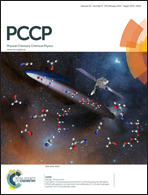X-ray absorption spectroscopy and resonant inelastic scattering study of the first lithiation cycle of the Li-ion battery cathode Li2−xMnSiO4
Abstract
We employ soft X-ray absorption spectroscopy and resonant inelastic X-ray scattering spectroscopy to study the redox behavior in the first lithiation/delithiation cycle of Li2−xMnSiO4 (4.0–4.6 V). For extraction of lithium ions up to an end potential of 4.1 V, we do not detect any change in the oxidation state for the expected redox-active Mn atom, instead the electronic structure of the Si–O network is affected. Above 4.1 V, there is an abrupt change in the oxidation state of the Mn-ions, from 2+ to 4+, which is accompanied by a complete loss of long range order in the material, as detected by X-ray diffraction. Further lithium extraction leads to progressive loss of crystallinity of Li2−xMnSiO4, rather than formation of a new structure, explaining the measured first-cycle capacity loss of this material. Our results suggest that future improvement of the crystalline stability of the material, particularly with respect to the SiO4 network, is required to harness the full charge capacity of Li2−xMnSiO4.


 Please wait while we load your content...
Please wait while we load your content...